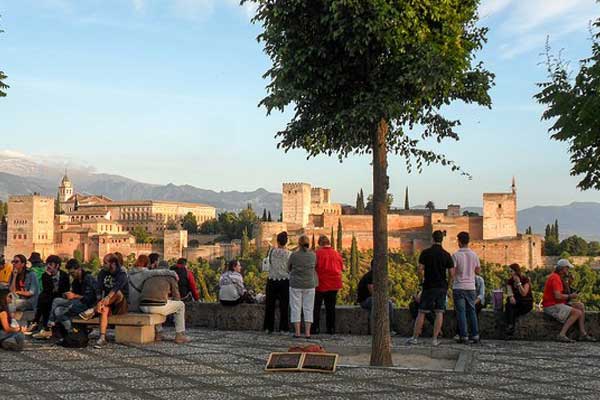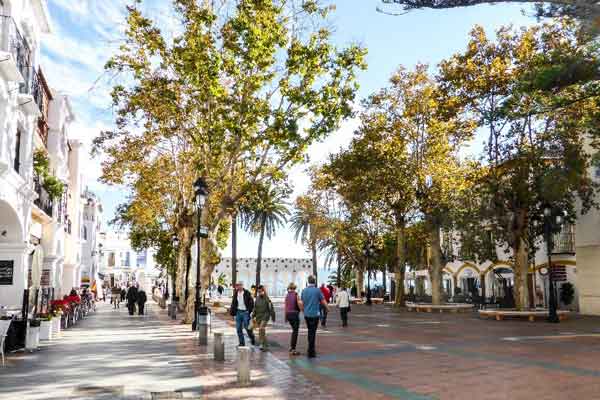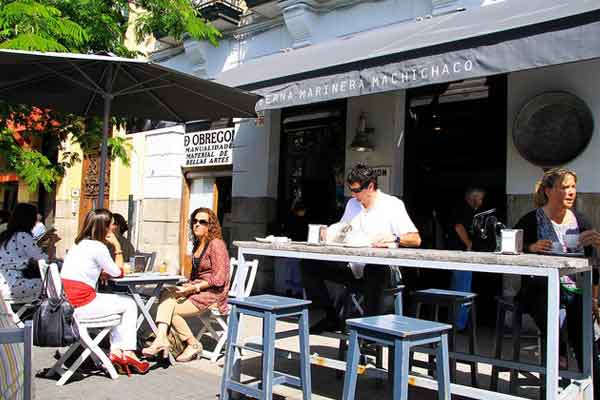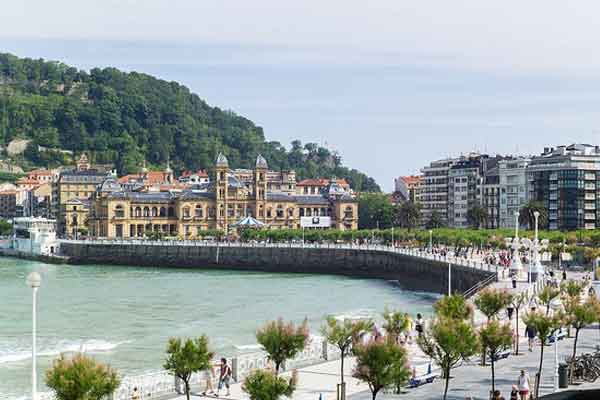Rulog Blog In Europe
Traditions and Culture in Spain
Bullfighting
Source: Harris Walker
2. Soccer
Source: Alberto Segade
3. Festivals
Source: Emilio García
4. Flamenco
Source: Nik
5. Tapas
Source: Drew Bates
6. The Siesta
Source: petter palander
7. Nightlife in Spain
Source: dr_zoidberg
8. Spanish Spices
Source: Javier Leiva
9. Dining Practices
Source: vasse nicolas,antoine
10. Religious Traditions
Source: Sandra Vallaure
Social Conventions and Etiquette

In Spain, it is polite to always greet people when you enter a room, an elevator, or the like. A simple buenos días or buenas tardes will do. (Use buenos días until lunchtime—about 1 p.m. or so. After that, use buenas tardes. If it’s evening, a simple buenas will do.)
Likewise, if you are getting on a bus, preparing to order in a restaurant, or addressing a shop attendant, it’s polite to greet them with a buenos días before launching into your request. And when you’re trying to attract the attention of that waiter or shop attendant, a polite por favor spoken in their direction is appreciated.
Greetings
As mentioned, be prepared to greet people with a polite buenos días even when you’re just entering an elevator.
When you are formally presented to someone, though, expect to give women a kiss on each cheek. You may shake hands with men, and—if it’s an informal presentation, among friends—women may also give men a kiss on each cheek. Men tend to kiss each other this way if they know each other well, but not normally on first meeting.
If you speak Spanish at all, expect to use the formal Usted form when greeting elders or those you don’t know well. In general, though, you likely will find Spaniards more informal than Latin Americans. Spaniards use the informal tú form widely and on short (or no) acquaintance (as well as its plural, vosotros, which is not used in Latin America). Expect to address friends of friends as tú from the outset. Ditto for colleagues, waiters and shop attendants, people you ask for directions in the street… I have even used it in business: in small meetings with clients, for instance.
Arrival Time
For social events like parties, do not arrive precisely on time. Being late is expected—at least a quarter of an hour. If it’s a large, prolonged event, even being very late (an hour or more) is fine.
However, for business meetings and dinner parties, being on time is expected.
Attire
Like many Europeans, Spaniards like being well dressed. Though casual dress has become more…well, casual…in recent years, there are still standards. Even when wearing jeans and sneakers, look “put together” and well groomed. In large cities, daytime casual wear for both men and women is often more formal than in the U.S. For casual nighttime outings, slacks or clean jeans for men and slacks or a skirt for women is usual.
For business, men should expect to wear a suit, unless they are in a creative profession in which business casual is the norm. For women, business casual is usual for most professions.
Relationships

Family
Spanish families have traditionally been tight-knit. Except in the very large cities, families often still eat lunch at home together. Major holidays, too, are usually spent together.
Though today 80% of the population lives in urban areas, most Spaniards are only one or two generations away from an agrarian life in a small village or town. As a result, many urban types in Madrid, Barcelona, and other metropolises maintain roots in the countryside, where extended family may still live. They may visit there on occasion, especially in the traditional August vacation season, or for family holidays and celebrations.
Marriage
Both religious and civil marriages are recognized in Spain. A religious ceremony—Roman Catholic, Protestant, Muslim, or Jewish—does not require a subsequent civil ceremony to be legal, but it must be registered with the local civil authorities for you to get a marriage certificate.
Civil marriages can take place between either heterosexual or same-sex couples. Civil marriages provide for rights to property, inheritance, pension, and adoption.
Most of Spain’s Autonomous Communities also allow registration of civil partnerships (pareja de hecho) between either heterosexual or same-sex couples. These allow for kinship, property, and inheritance rights.
Friendships
Spaniards generally are outgoing and friendly. It is easy to strike up conversation with them at a bar, café, or even in the street. They enjoy having fun…and they’re happy to take you along for the ride. But they can also be quite private about their home life, especially older Spaniards. So even when they are genuinely friendly and warm in public, it may take time before they extend you an invitation to their homes. Don’t take it personally. When that invitation does come, it will be warm and welcoming.
Food and Drink

In recent decades, Spain’s rich and varied culinary tradition has begun getting the recognition it deserves. Tapas, of course, gained fame some time ago. But they’re just the start of Spanish cuisine.
Meal time. Spanish meal times skew later than anywhere else in Europe—and they love it that way.
Breakfast is usually a light meal: just coffee (usually a café con leche, or strong coffee with milk), or coffee with a pastry or roll. Spaniards generally then take a mid-morning break, when they may have something more substantial, such as a larger pastry, a small sandwich, or a slice of tortilla, to hold them over until lunch. (And the Spanish tortilla is an egg-based dish with a range of other ingredients, rather like an Italian frittata. The classic tortilla española is eggs, potato, and sometimes onion.) It’s usually accompanied by a café con leche.
Lunch is the big meal of the day, usually served at 2 p.m. or 3 p.m. (And except in high tourist areas, restaurants aren’t open for lunch before at least 1 p.m.) It’s a sit-down meal with friends or family, and it lasts an hour to an hour and a half—even longer if it’s a business lunch, a special occasion…or you just have the time to spare.
In many regions, people may meet at an outdoor café, or terraza, for a drink before lunch. This can be wine (white or rosé) or, increasingly, a beer or soft drink. A small snack, or tapa, is usually served with the drink.
Lunch, or comida, is usually two courses, plus bread, a beverage, followed by coffee and/or dessert. The first course can be salad, a soup, prepared vegetables (grilled or sautéed)…even paella. The second, main course is often meat or fish, accompanied by potatoes or another vegetable. Wine, water, and beer are the traditional beverages—though many young people now drink soft drinks.
Dessert traditionally was fresh fruit, and still is in many homes. But in restaurants today you are likely to be offered cakes, pies, and pastries instead. (Flan and arroz con leche—rice pudding—are two traditional Spanish desserts that you’ll still see often.) After-lunch coffee tends to be café solo (an espresso) or a cortado (an espresso cut with a dash of hot milk). At leisurely lunches, the post-prandial coffee is often accompanied by a licor (liqueur), of which Spain has a plethora.
At about 6 p.m., small children may be served a merienda, a snack of some sort, with a glass of milk or cocoa. A couple of hours afterwards, their elders may head out to bar hop and enjoy tapas. These small snacks traditionally accompany an alcoholic drink—beer, wine, or sherry. While many bars still adhere to the tradition of free tapas, increasingly you’ll find specialized tapas bars that charge for them (and which you’ll eat instead of dinner). Bars in many parts of Andalucía traditionally charge for tapas, for instance—but serve quite large portions. In northern Spain, tapas—particularly ingredients served on a slice of bread—are called pinchos, or pintxos.
Travel and Driving

If you are a tourist in Spain and want to drive a car, it’s advisable to get an International Driver’s License. (You can likely rent a car without one, but if you commit a driving infraction and are stopped by the police, the officer may ask to see one.)
Note that most cars available for rent in Spain are manual transmission. You may need to request an automatic transmission if you need one…and you may pay more for it. Spaniards drive on the right and overtake on the left; it’s considered bad manners to continually drive on the left.
Spanish Superstitions
Forget Friday 13th being unlucky! In Spain its Tuesday the 13th you should be worried about! Tuesday is believed to be dominated by Ares, the Greek god of war, who gives his name to Martes, or Tuesday, in Spanish. An old proverb explains this superstition: “On Tuesday, don’t get married, embark on a journey or move away (En martes, ni te cases, ni te embarques, ni de tu casa te apartes)
HATS GO ON HEADS NOT BEDS
In Spain, putting a hat on a bed could bring bad luck. Years ago, it was believed that evil spirits lived in your hair. Therefore they could easily be transferred from hair to hat and then to your bed, which would result in evil spirits getting you in the night.
SEVEN LIVES
While many countries believe cats having nine lives because of their suppleness and cleverness at getting out of difficult situations, the poor Spanish moggies have just seven.
STRAIGHT TO THE POINT
Never buy family or friends knives or scissors as a gift. Tradition has it that this means that your relationship will be cut.
EXTRA CHAIR FOR MY BAG PLEASE
Always ensure there is an extra chair at your table in Spain for your handbag. Or buy one of those clever clasps in the market. Spanish people believe if you leave your handbag on the floor it will result in you losing your money.
BREAK A LEG
Why wish harm on people as a sign of good luck? Theatres have always had first night superstitions and while in many countries “break a leg” is the way to wish good luck, in Spain you must wish the person “mucha mierda” or “loads of sh**”
CACTUS
Why are there so many cacti on Spanish window sills? Because the Spanish widely believe that a cactus can ward off evil.
DON’T GET SWEPT OFF YOUR FEET
A superstition relating to witches it that if, whilst sweeping the floor, you accidentally brush the feet of a single woman, she will never marry .
NEVER BUY YELLOW CLOTHES AS A GIFT
It is believed that yellow represents sulphur and the Devil and so the colour yellow is said to bring bad luck in certain situations. Therefore never wear yellow on the day of an exam or job interview.
LUCKY NEW YEAR
At midnight on New Year’s Eve, Spaniards traditionally eat 12 grapes on the 12 strokes of midnight for luck. And for even more prosperity and luck for the year ahead, wearing red underwear that night too!
BEST FOOT FORWARD
It is said that misfortune enters the room with the left foot. But if you do unfortunately enter a room with your left foot – don’t worry. Just make sure to make the sign of the cross 3 times to counter the bad luck.

Spain’s culture is such a fascinating blend of tradition, rhythm, and warmth — from flamenco to siestas, every detail feels alive with meaning. Reading this reminded me of how travel isn’t just about seeing places but feeling their pulse, much like the curated journeys by Rajniva Destinations, where every stay across India tells its own story of heritage and soul.
ReplyDelete